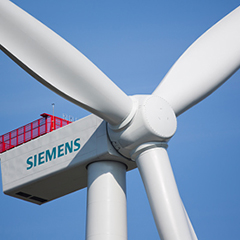• Installed capacity in Klixbüll rises from 15 to 39 megawatts
• Reactive Power at No Wind to stabilize the grid
Siemens Energy has been awarded an order for the community wind power plant Klixbüll in Schleswig-Holstein. Eight modern wind turbines with direct drive technology and a 3 megawatts (MW) capacity each will be installed at the onshore project close to the coast of the North Sea near the Danish border. The fully citizen-owned Zweite Klixbüller Energie GmbH & Co. KG with the new wind farm extends the locally installed capacity by 24 MW up to 39 MW till autumn. Even in case of no wind an innovative feature to stabilize the grid by supplying wattless power assures additional profit to the project. Moreover, Siemens provides a 20-year-maintenance in the framework of a full service contract.
Six SWT-3.6-107 turbines have been in operation at the windy site in the region of Nordfriesland. Two of them are the basis of the first community wind farm of Klixbüll commissioned in 2006. Another eight SWT-3.0-113 wind turbines with a rotor diameter of 113 meters and a capacity of 3 MW will not only more than double the total capacity, but also provide technological features that will make the project even more profitable. Once the installation will be completed this fall, the wind farm will contribute to the energy transition even in the case of complete wind calm. A key feature is the “Reactive Power at No Wind” option which turns the wind turbines into a phase shifting VAR compensator which then solve a technical problem in the AC voltage grid: Industrial customers who draw large amounts of active power from the grid can disrupt the supply frequency because of their need for reactive power and may lead to a heating of the power lines. Through “Reactive Power at No Wind”, the wind farm can counteract this frequency shift and hence stabilize the AC grid. The operator of a wind farm produces in that way reactive power itself and offers it to the grid operator. This can heavily reduce the annual operating costs.



























